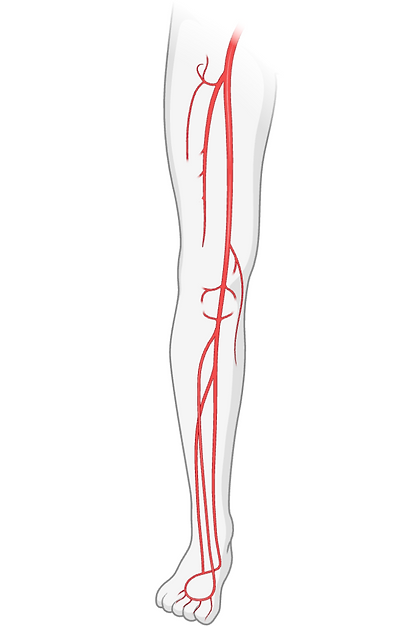Peripheral Vascular Disease
Peripheral vascular disease typically refers to the development of narrowing and blockage of the arteries in the legs (lower limbs). This is primarily due to atherosclerosis, the build-up of plaques in the wall of the arteries.

Peripheral Vascular Disease
Peripheral vascular disease typically refers to the development of narrowing and blockage of the arteries in the legs (lower limbs). This is primarily due to atherosclerosis, the build-up of plaques in the wall of the arteries, and may be due to diabetes, smoking, cholesterol and other risk factors. Symptoms that can occur include pain in the thigh or calf when walking (claudication), wounds or ulcers on the foot, and coldness or numbness in the foot.
Treatment generally begins with modification of risk factors and medication, but you may require an interventional radiology procedure (endovascular surgery) to treat a narrowing or blockage if you have significant symptoms.
Angiography (Angiogram)
Angiography (angiogram) refers to the procedure performed to diagnose the disease in the artery. This involves placement of a small catheter tube into the groin artery and injecting a contrast die to show the areas of narrowing or blockage under x-ray imaging. The procedure is usually performed under local anaesthetic and light sedation. Several decades ago, interventional radiologists first utilised this imaging technique to pioneer angioplasty and stent insertion.
Angioplasty & Stent Insertion
Angioplasty refers to the technique of dilating a narrowing or blockage within an artery to improve blood flow by using a balloon inserted under x-ray guidance. Stent insertion is where a metal mesh tubing is placed across the narrowing or blockage to hold it open and provide improved blood flow. A combination of angioplasty ("ballooning") and stent insertion may be required to provide the best outcome for a particularly narrowing or blockage in an artery.
Effectiveness
-
The effective and long term patency rates are different depending on the location of the narrowing or blockage and the severity of the narrowing or blockage
-
Follow up imaging and monitoring will be arranged and you will be informed about the expected success rates and if further treatment is required
-
You may be prescribed an antiplatelet ("blood thinner") medication after your procedure, particularly if a stent was inserted, which helps to prevent further narrowing or blockage in the future
Procedure
-
A specialist interventional radiologist will first consult and examine you preoperatively
-
Most angiography and angioplasty procedure are performed under sedation and local anaesthetic via a small catheter tube inserted into the femoral artery in your groin. In some cases, bilateral (both sides) access in the groin, or access into an upper limb (arm) artery may be required.
-
The procedure typically take between 1 and 2 hours
-
There may be a closure device or "stitch" used to seal the site where the catheter was inserted into the artery
-
You will be required to lie down and rest in bed for up to 4 hours post-operatively, which is to minimise bruising in the groin.
-
Some patients experience a "reperfusion" feeling, where the treated leg feels warmer and may be painful with throbbing after the procedure. This is actually a good outcome, and is because the body is adjusting to the improved blood flow. It typically resolves after 6 to 12 hours.
-
Angiography and angioplasty procedures may be performed as a day-case or with an overnight hospital stay depending on complexity
Complications
The overall risk of complications is different depending on the location, severity and length of the narrowing or blockage being treated. Complications may include:
-
Groin bruising or haematoma (bleeding lump)
-
Damage to an artery resulting in decreased blood flow
-
Closure of small arteries lower down in the foot
Specialist Expertise
Interventional Radiologists (IRs) are specialty trained in the care of patients undergoing angiography and angioplasty, including the pre-procedural assessment, operation and post-procedural care. It was an Interventional Radiologist (IR) named Charles Dotter in 1964 who first pioneered the angioplasty procedure, performed in a patient with a narrowing in the femoral (leg) artery, spawning a new minimally invasive treatment option that has since become the standard of care. Interventional Radiologists (IRs) have the longest collective experience of any specialty group in angiography and angioplasty procedures, and regularly perform angiography all throughout the body, including the aorta, upper limbs, lower limbs and visceral (organ) arteries.
Preparation and Referral
If you would like to consult with an Interventional Radiologist about angiography and angioplasty, please send a referral for consultation, including the following
-
Imaging results including ultrasound, CT, and other imaging
-
Records of consultations with other doctors and specialists
Public eligible patients can undergo the treatment with no out-of-pocket expense in the public system. Peripheral vascular disease treatment is provided at most of our public and private hospital locations in Melbourne, Victoria, Australia.
Peripheral Vascular Disease (PVD) content by Dr Matthew Lukies.

